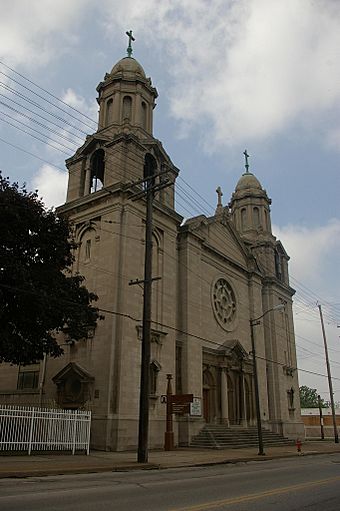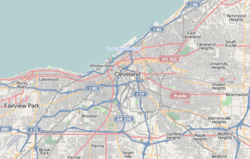St. Elizabeth of Hungary Shrine (Cleveland) facts for kids
Quick facts for kids |
|
|
St. Elizabeth of Hungary Shrine
|
|

Front, seen from east
|
|
| Location | 9016 Buckeye Rd., Cleveland, Ohio |
|---|---|
| Area | Less than 1 acre (0.40 ha) |
| Built | 1918 |
| Architect | Emile M. Uhlrich |
| Architectural style | Italian Baroque |
| NRHP reference No. | 76001402 |
| Added to NRHP | January 30, 1976 |
| St. Elizabeth of Hungary Shrine | |
|---|---|
| Administration | |
| Diocese | Diocese of Cleveland |
The St. Elizabeth of Hungary Shrine is a special historic church in Cleveland, Ohio. It's on the east side of the city, in the Buckeye Road area. This church is important because it was the very first Catholic parish in the United States created specifically for Hungarian people. The building you see today was built a long time ago, in the early 1900s. It's so important that it's been named a historic site! In 2023, Bishop Edward C. Malesic made it a special 'shrine church.' This means it helps share the Christian history of Hungarian people. It also holds church services using older traditions, and it's currently run by a group called the Institute of Christ the King Sovereign Priest.
Contents
How the Parish Started
At first, Hungarian Catholics in Cleveland went to a Slovakian church called St. Ladislaus'. But as more Hungarian people moved to the area, they wanted their own church. They also had some disagreements with the Slovakian community.
So, Bishop Horstmann helped them get permission from church leaders. In late 1892, a priest named Charles Boehm came from Hungary to Cleveland. He was there to start the new St. Elizabeth parish. This was the first Hungarian Catholic parish in all of America!
Father Boehm immediately started signing up new members. He also pushed for a church building to be built. By the end of 1893, the first brick church was finished. A school was built soon after, and a bigger school was completed in 1900 because so many kids joined. Father Boehm also started a newspaper in the Hungarian language for the parish. It became very popular, even in other parts of the United States and in Hungary.
Father Julius Szepessy took over in 1907 when Father Boehm left to start other Hungarian missions. But after Szepessy passed away in 1923, Father Boehm came back. He stayed until he retired in 1927.
Growth and Changes
In 1904, the parish became a bit smaller. This happened because Hungarian Catholics living on the west side of Cleveland found it hard to travel three hours to get to Mass. With Father Boehm's help, a new church called St. Emeric's was created for them. This was the first of more than a dozen Hungarian parishes that started because of Father Boehm's work.
Even with some people leaving, Father Boehm still had many parishioners. The old church building was not big enough for everyone. Before he left in 1907, he had already started raising money for a new, bigger church. Father Szepessy saw the new church building finished, along with a parish hall. This hall became a very important meeting place for the Hungarian community in the neighborhood.
In July 2023, Bishop Edward C. Malesic announced that St. Elizabeth's would become a shrine church. This was so it could continue to use the older form of Mass, known as the Tridentine Mass. After this announcement, Bishop Malesic invited the Institute of Christ the King Sovereign Priest to take over the church. They would celebrate the traditional Mass and other sacraments (holy ceremonies) as they were done before the changes made by Pope Paul VI. Canon James Hoogerwerf from the Institute was named the new leader (rector) of St. Elizabeth's. The first Mass held by the Institute was on September 24, 2023.
Church Design and Style
The first St. Elizabeth's church was a simple brick building. It was built in 1893 and looked like a basic Gothic Revival style. This building was taken down in 1917 to make way for the church we see today.
The cornerstone for the current church was placed in 1918. However, building it took a long time, and it was finally finished in 1922. The church is mostly made of limestone. It was designed by a Cleveland architect named Emile Uhlrich. The church's style is called Italian Baroque. It was partly inspired by a famous church in Rome called Sant'Agnese in Agone.
The front of the church has two tall towers. Each tower has a small dome, called a cupola, on top. In the middle of the front, high above the main entrance, there is a large round window called a rose window. A set of steps leads up from the sidewalk to the main entrance. The church building is right next to the sidewalk, with no space set back from the street.
Protecting a Historic Place
In 1976, St. Elizabeth's Church was added to the National Register of Historic Places. It earned this honor because of its important role in the area's history and its special architecture. The building has been kept in good condition, partly thanks to money left to the church by generous people.
However, the number of members has dropped a lot from when the parish was at its busiest. Most of the Hungarian residents in the neighborhood moved away in the 1970s. This was mainly because factory jobs disappeared and crime rates went up quickly. But other Hungarian churches, like St. Emeric's on the west side and St. Margaret's in Orange, Ohio, also became weaker. Because of this, Bishop Lennon closed those two parishes in early 2009. He encouraged their members to start going to St. Elizabeth's instead.





